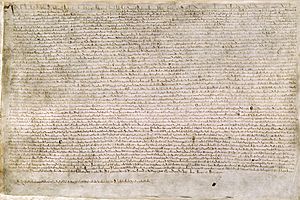George Ferrers facts for kids
Quick facts for kids Magna Carta |
|
 Magna Carta, Cotton MS. Augustus II. 106, property of the British Library
|
George Ferrers (born around 1500, died 1579) was an important person in the royal court and a writer. He is famous for his role in creating a special rule called parliamentary privilege. This rule protects members of Parliament. He also wrote for a well-known book called The Mirror for Magistrates. George Ferrers wrote plays for the King's court, especially sad plays called tragedies. Sadly, these plays were never published and are now lost.
Contents
Who Was George Ferrers?
George Ferrers was the oldest son of Thomas Ferrers and Alice Cockworthy. He was born in St Albans, England. He studied at the University of Cambridge and later joined Lincoln's Inn, a place where lawyers trained. Even though he was praised for his speaking skills, it's not clear if he worked as a lawyer.
Early Writings and Royal Service
George Ferrers was very interested in law and history. In 1533, he helped edit and translate a big book of laws called "The Great Boke of Statutes." He also translated the famous Magna Carta into English in 1534.
By 1538, Ferrers started working for King Henry VIII's main advisor, Thomas Cromwell. After Cromwell lost his power, Ferrers continued to serve the King directly. He was even there when Henry VIII met his fourth wife, Anne of Cleves. From 1542 to 1547, he worked as a "page of the chamber," which meant he was a personal assistant to the King. He even went with the King to France in 1544. When King Henry VIII died in 1547, he left George Ferrers a small gift in his will.
Ferrers and Parliament's Power
George Ferrers was a Member of Parliament (MP) for several areas, including Plymouth, Cirencester, and St Albans. His most famous moment in politics is known as the "Ferrers Case."
The "Ferrers Case" of 1542
In March 1542, Ferrers was arrested for a debt. This happened while he was on his way to the House of Commons (part of Parliament). His fellow MPs were very upset. They ordered the Serjeant-at-Arms (an officer of Parliament) to get Ferrers released.
When the Serjeant tried to free Ferrers, there was a fight. The Serjeant's special staff, called a mace, was even broken. The city sheriffs, who had arrested Ferrers, were called to Parliament. They were told that arresting an MP during a Parliament session was a serious offense.
The King himself got involved. He said that Parliament and the King were like "one body politic." This meant that any harm to a member of Parliament was like harming the King himself and the entire Parliament. Because of this incident, it became a rule that members of Parliament could not be arrested for civil debts while Parliament was meeting. This rule is called parliamentary privilege.
Ferrers' Later Life and Entertainment Work
After the "Ferrers Case," George Ferrers continued to serve the Crown. In 1547, he helped with transporting goods during a war in Scotland. He also survived the fall of a powerful leader named Somerset.
Entertaining King Edward VI
In 1551, a new powerful leader, the Duke of Northumberland, asked Ferrers to create fun shows for the young King Edward VI during Christmas. Ferrers was appointed "Lord of Misrule," a special role for organizing festive events. He put on many amazing shows, including plays, jousting tournaments, and parades. People said he was better than anyone before him at creating these entertainments.
Ferrers was asked to be the Lord of Misrule again the next Christmas season. He organized more jousting, a mock midsummer show, and special plays called masques. For his great work, he was given an estate (a large piece of land) at Flamstead. He even continued to organize entertainments for the new Queen, Mary I, in 1553.
Later Years and Literary Contributions
In 1554, Ferrers was rewarded for his help during a rebellion. Later, he was involved in a strange incident with a famous scholar named John Dee. Ferrers accused Dee and his friends of witchcraft. Dee was arrested, but not much is known about what happened to Ferrers after this. He was not recorded at court during Queen Elizabeth's reign.
George Ferrers is also well-known for his writing in The Mirror for Magistrates. This book contained sad stories about important people who had fallen from power. He wrote several parts for this book, including tragedies about Tresilian and Thomas of Woodstock. He also wrote verses for a big party held for Queen Elizabeth at Kenilworth Castle in 1575.
Some writers in the past mistakenly called him "Edward Ferrers." This caused confusion about his work for many years. However, historians later corrected this mistake.
George Ferrers died at Flamstead in Hertfordshire and was buried there on January 11, 1579.
Family Life
George Ferrers was married three times. His first wife was Elizabeth, who was already a widow. He married her by 1541. His second wife was Jane Southcote, whom he married in 1546. They had a son named Julius. His third wife was Margaret Preston, whom he married in 1569. They had at least three more sons and two daughters.

